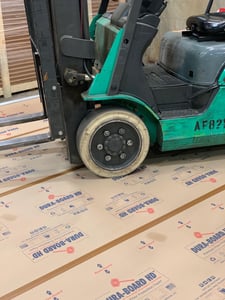 Any kind of construction project, from a simple one-room remodel to a full-scale building being erected, needs a foundation. And while the literal foundation of a building is one of the first steps in some construction projects, the actual foundation of every project is site preparation. The following four categories combine to encompass proper site preparation for every successful construction project:
Any kind of construction project, from a simple one-room remodel to a full-scale building being erected, needs a foundation. And while the literal foundation of a building is one of the first steps in some construction projects, the actual foundation of every project is site preparation. The following four categories combine to encompass proper site preparation for every successful construction project:
Clearing and cleaning
The first step in proper site preparation is to clear away any obstacles and get the site as clean as is practical.
If you're building a home, this is the stage where the plot is cleared of trees and rocks, a foundation or basement is dug, and the area where a slab is going to be poured gets leveled off. This step could also be as simple as moving furniture and fixtures out of a room you're planning to renovate and giving it a quick once-over with the vacuum cleaner.
Doing this step right allows you to properly visualize the entire future project, and allows you to remove anything that might impede the work that needs to come next.
Safety first
The next consideration is safety. Because there many be many people working in this area using heavy equipment, power tools, and a number of small sharp objects, there's already plenty of potential for danger. It's important that the site itself doesn't present any additional causes for concern.
On a home plot, it's necessary to clear any main traffic areas where vehicles or people will be traveling, put clear signs and barriers up where there are holes or dips in the ground surface, and make arrangements for tools and supplies to be safely stored when not in use.
For a smaller project, it may be as simple as making sure you have the proper safety equipment on hand, that your tools and materials are in safe working order, and you know what you're doing.
Protecting what's there
Another aspect of site preparation that hinges on both cleaning and safety is taking the time and effort to protect aspects of the site that could be harmed by the work being done.On your home site, there may be trees or other landscaping elements you want to preserve. Or, perhaps there are expensive materials on site that need to be protected from damage or theft.
Any time work is being done on an existing building, there's likely to be flooring, cabinets, walls, and other surface areas that are not directly involved in the project, but that are going to endure a lot of traffic, heavy objects being dropped or moved, paint or stain being spilled, and other construction related wear and tear.
One of the most popular ways to protect surfaces on a construction site is to lay down one or more options of our Floor Papers over the vulnerable surfaces. Heavy weight Construction floor board comes in 38" X 100' rolls of thick, water-resistant chipboard, making it the most durable protection alternative. Lighter weight Floor Paper rolls are 36" X 144' rolls of kraft, which can be used to cover walls, windows, or an entire floor surface in just a few minutes.
Pro tip: for some great advice, review our previous blog post: 4 Quick Tips for Using Construction Floor Paper on Job Sites.
Preparing to build
Finally, with the construction site clean, clear, safe, and protected, you're ready to build.
Prepare to do so by having all the tools and materials you need handy. Make sure you have enough room to maneuver materials so you're not going to damage anything getting it in place. Set aside enough time to get the job done right without having to rush or cut corners. And finally, get down to business! Want to learn more about construction floor paper for your next construction job? Our paper converting company is here to answer your questions and help you get started.



